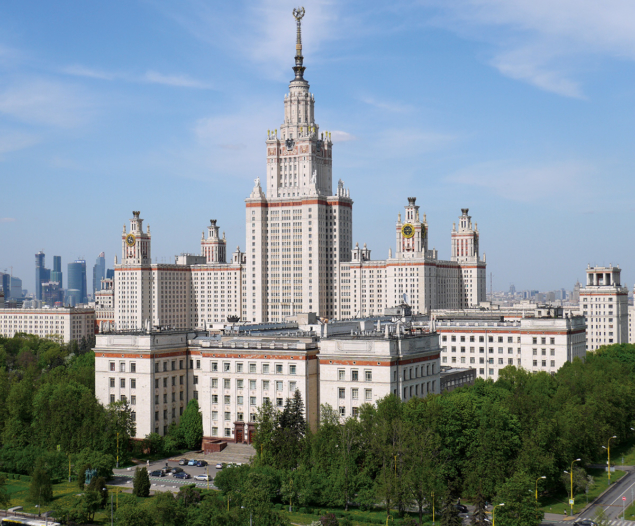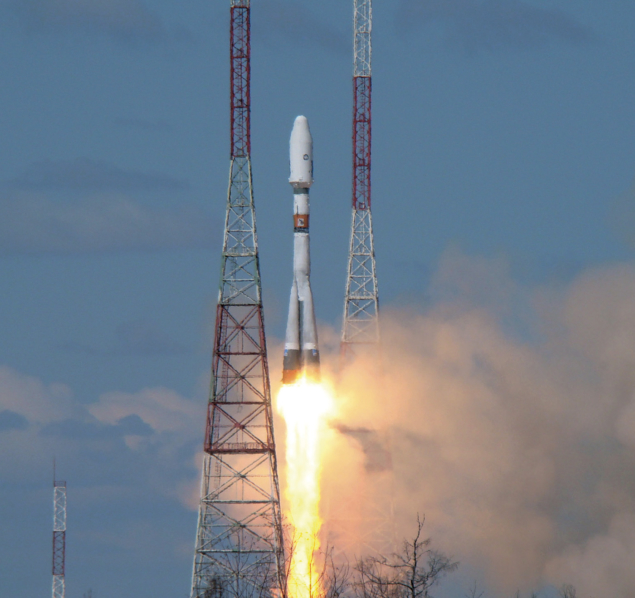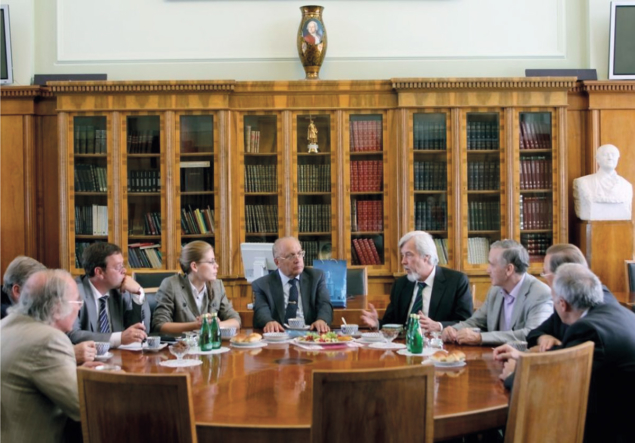Eduard Boos and Victor Savrin look back at 75 years of developments at Russia’s Skobeltsyn Institute of Nuclear Physics, which range from pioneering satellite experiments to participation in the LHC-experiment upgrades.

The Skobeltsyn Institute of Nuclear Physics (SINP) was established at Lomonosov Moscow State University (MSU) on 1 February 1946, in pursuance of a decree of the government of the USSR. SINP MSU was created as a new type of institute, in which the principles of integrating higher education and fundamental science were prioritised. Its initiator and first director was Soviet physicist Dmitri Vladimirovich Skobeltsyn, who was known for his pioneering use of the cloud chamber to study the Compton effect in 1923 – aiding the discovery of the positron less than a decade later.
It is no coincidence that SINP MSU was established in the immediate aftermath of the Second World War, following the first use of nuclear weapons in conflict. The institute was created on the basis that it would train personnel who would specialise in nuclear science and technology, after the country realised that there was a shortage of specialists in the field. Thanks to strong leadership from Skobeltsyn and one of his former pupils, Sergei Nikolaevich Vernov, SINP MSU quickly gained recognition in the country. As soon as 1949, the government designated it a leading research institute. By this time a 72 cm cyclotron was already in use, the first to be used in a higher education institute in the USSR.
Skobeltsyn and Vernov continued with their high ambitions as they expanded the facility to the Lenin Hills, along with other scientific departments in MSU. Proposed in 1949 and opened in 1953, the new building in Moscow was granted approval to build a set of accelerators and a special installation for studying extensive air showers (EASs). The first accelerator built there was a 120 cm cyclotron, and its first outstanding scientific achievement was the discovery by A F Tulinov of the so-called “shadow effect” in nuclear reactions on single crystals, which makes it possible to study nuclear reactions at ultra-short time intervals. Significant scientific successes were associated with the commissioning of a unique installation, the EAS-MSU, at the end of the 1950s for the study of ultra-high-energy cosmic rays. Several results were obtained through a new method for studying EASs in the region of 1015–1017 eV, leading to the discovery of the famous “knee” in the energy spectrum of primary cosmic rays.
The space race
1949 marked SINP MSU’s entrance into astrophysics and, in particular, satellite technology. The USSR’s launch of Sputnik 1, Earth’s first artificial satellite, in 1957 gave Vernov, an enthusiastic experimentalist who had previously researched cosmic rays in the Earth’s stratosphere, the opportunity to study outer-atmosphere cosmic rays. This led to the installation of a Geiger counter on the Sputnik 2 satellite and a scintillation counter on Sputnik 3, to enable radiation experiments. Vernov’s experiments on Sputnik 2 enabled the first detection of the outer radiation belt. However, this was not confirmed until 1958 by the US’s Explorer 1, which carried an instrument designed and built by James Van Allen. Sputnik 3 confirmed the existence of an inner radiation belt, having received information from Australia and South America, as well as from sea-based stations.

Vernov, who was Skobeltsyn’s successor as SINP director in 1960–1982, later worked on the “Electron” and “Proton” series of satellites, which studied the radiation-belt structure, energy spectra and temporal variations associated with geomagnetic activity. This led to pioneering results on the spectrum and composition of galactic cosmic rays, and to the first model of radiation distribution in near-Earth space in the USSR.
SINP MSU has carried on Vernov’s cosmic legacy by continuing to develop equipment for satellites. Since 2005 the institute has developed its own space programme through the university satellites Tatiana-Universitetsky and Tatiana-2, as well as the Vernov satellite. These satellites led to new phenomena such as ultraviolet flashes from the atmosphere being discovered. In 2016 a tracking system for ultraviolet rays was installed on board the Lomonosov satellite (see “Vernov’s legacy” image), developed at SINP MSU under the guidance of former director Mikhail Igorevich Panasyuk. This allowed fluorescence light radiated by EASs of ultra-high-energy cosmic rays to be measured for the first time, and prompt-emission observations of multi-wavelength gamma-ray bursts. The leading role of the entire mission of the Lomonosov satellite belongs to the current rector of MSU, Victor Sadovnichy.
High-energy exploration
In 1968, under strong endorsement by Vernov and the director of a new Russian accelerator centre in Protvino, Anatoly Alekseyevich Longunov (who went on to be MSU rector from 1977 to 1991), a department of high-energy physics was established under the leadership of V G Shevchenko at SINP MSU, and the following year it was decided that a high-energy laboratory would be established at MSU. Throughout the years to follow, collaborations with laboratories in USSR and across the world, including CERN, Fermilab, DESY and the Joint Institute for Nuclear Research (JINR), lead the department to be at the forefront of the field.
At the end of the 1970s a centre was created at SINP MSU for bubble-chamber film analysis. At the time it was one of the largest automated complexes for processing and analysing information from large tracking detectors in the country. In collaboration with other institutes worldwide, staff at the institute studied soft hadronic processes in the energy range 12–350 GeV at a number of large facilities, including the Mirabelle Hydrogen Bubble Chamber and European Hybrid Spectrometer.
Extensive and unique experimental data have been obtained on the characteristics of multiple hadron productions, including fragmentation distributions. Throughout the years, exclusive reaction channels, angular and momentum correlations of secondary particles, resonance production processes and annihilation processes were also investigated. These results have made it possible to reliably test the predictions of phenomenological models, including the dual-parton model and the quark–gluon string model, based on the fundamental theoretical scheme of dual-topological unitarisation.
For the first time in Russia, together with a number of scientific and technical enterprises with the leading role of the SINP MSU, an integrated system has now been created for the development, design, mass production and testing of large silicon solid and microstrip detectors. On this basis, at the turn of the millennium a hadron–electron separator was built for the ZEUS experiment at HERA, DESY.

The institute delved into theoretical studies in 1983, with the establishment of the laboratory of symbolic computations in high-energy physics and, in 1990, the department of theoretical high-energy physics. One of its most striking achievements was the creation of the CompHEP software package, which has received global recognition for its ability to automate calculations of collisions between elementary particles and their decays within the framework of gauge theories. This is freely available and allows physicists (even those with little computer experience) to calculate cross sections and construct various distributions for collision processes within the Standard Model and its extensions. Members of the department later went on to make a significant contribution to the creation of a Tier-2 Grid computer segment in Russia for processing and storing data from the LHC detectors.
Over the past 35 years of research in the field of particle accelerators at SINP MSU, research has moved from the development of large accelerator complexes for fundamental research, to now focusing on the creation and production of applied accelerators for security systems, industry and medicine.
Teaching legacy
Throughout its 75 years, SINP MSU has also nurtured thousands of students. In 1961 a new branch of SINP MSU, the department for nuclear research, was established in Dubna. It became the basis for training students from the MSU physics faculty in nuclear physics using the capabilities of the largest international scientific centre in Russia – JINR. The department, which is still going strong today, teaches with a hands-on approach, with students attending lectures by leading JINR scientists and taking part in practical training held at the JINR laboratories.
The institute is currently participating in the upgrade of the LHC detectors (CMS, ATLAS, LHCb) for the HL-LHC project, as well as in projects within the Physics Beyond Colliders initiative (e.g. NA64, SHiP). These actions are under the umbrella of a 2019 cooperation agreement between CERN and Russia concerning high-energy physics and other domains of mutual interest. Looking even further ahead, SINP MSU scientists are also working on the development of research programmes for future collider projects such as the FCC, CLIC and ILC. Furthermore, the institute is involved in the upcoming NICA Complex in Russia, which plans to finish construction in 2022.
After 75 years, the institute is still as relevant as ever, and whatever the next chapter of particle physics will be, SINP MSU will be involved.







